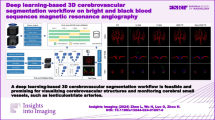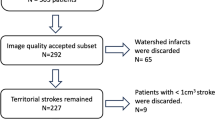Abstract
Ischemic strokes are often caused by large vessel occlusions (LVOs), which can be visualized and diagnosed with Computed Tomography Angiography scans. As time is brain, a fast, accurate and automated diagnosis of these scans is desirable. Human readers compare the left and right hemispheres in their assessment of strokes. A large training data set is required for a standard deep learning-based model to learn this strategy from data. As labeled medical data in this field is rare, other approaches need to be developed. To both include the prior knowledge of side comparison and increase the amount of training data, we propose an augmentation method that generates artificial training samples by recombining vessel tree segmentations of the hemispheres or hemisphere subregions from different patients. The subregions cover vessels commonly affected by LVOs, namely the internal carotid artery (ICA) and middle cerebral artery (MCA). In line with the augmentation scheme, we use a 3D-DenseNet fed with task-specific input, fostering a side-by-side comparison between the hemispheres. Furthermore, we propose an extension of that architecture to process the individual hemisphere subregions. All configurations predict the presence of an LVO, its side, and the affected subregion. We show the effect of recombination as an augmentation strategy in a 5-fold cross validated ablation study. We enhanced the AUC for patient-wise classification regarding the presence of an LVO of all investigated architectures. For one variant, the proposed method improved the AUC from 0.73 without augmentation to 0.89. The best configuration detects LVOs with an AUC of 0.91, LVOs in the ICA with an AUC of 0.96, and in the MCA with 0.91 while accurately predicting the affected side.
Access this chapter
Tax calculation will be finalised at checkout
Purchases are for personal use only
Similar content being viewed by others
References
Amukotuwa, S.A., Straka, M., Dehkharghani, S., Bammer, R.: Fast automatic detection of large vessel occlusions on CT angiography. Stroke 50(12), 3431–3438 (2019)
Amukotuwa, S.A., et al.: Automated detection of intracranial large vessel occlusions on computed tomography angiography: a single center experience. Stroke 50(10), 2790–2798 (2019)
Caplan, L.R.: Arterial occlusions: does size matter? J. Neurol. Neurosurg. Psychiatry 78(9), 916 (2007)
Chefd’Hotel, C., Hermosillo, G., Faugeras, O.: Flows of diffeomorphisms for multimodal image registration. In: Proceedings IEEE International Symposium on Biomedical Imaging, pp. 753–756 (2002). https://doi.org/10.1109/ISBI.2002.1029367
Hara, K., Kataoka, H., Satoh, Y.: Can spatiotemporal 3D CNNs retrace the history of 2D CNNs and imagenet? In: Proceedings of the IEEE Conference on Computer Vision and Pattern Recognition (CVPR), pp. 6546–6555 (2018)
Huang, G., Liu, Z., Van Der Maaten, L., Weinberger, K.Q.: Densely connected convolutional networks. In: IEEE Conference on Computer Vision and Pattern Recognition (CVPR), pp. 4700–4708 (2017). https://doi.org/10.1109/CVPR.2017.243
Kemmling, A., Wersching, H., Berger, K., Knecht, S., Groden, C., Nölte, I.: Decomposing the hounsfield unit. Clin. Neuroradiol. 22(1), 79–91 (2012). https://doi.org/10.1007/s00062-011-0123-0
Kingma, D.P., Ba, J.: Adam: A method for stochastic optimization (2015)
Luijten, S.P., et al.: Diagnostic performance of an algorithm for automated large vessel occlusion detection on CT angiography. J. Neurointerventional Surg. 14(8), 794–798 (2021). https://doi.org/10.1136/neurintsurg-2021-017842
Paszke, A., et al.: Pytorch: an imperative style, high-performance deep learning library. Adv. Neural Inf. Process. Syst. 32 (2019)
Pérez-García, F., Sparks, R., Ourselin, S.: Torchio: a python library for efficient loading, preprocessing, augmentation and patch-based sampling of medical images in deep learning. Comput. Methods Programs Biomed. 208, 106236 (2021). https://doi.org/10.1016/j.cmpb.2021.106236
Stib, M.T., et al.: Detecting large vessel occlusion at multiphase CT angiography by using a deep convolutional neural network. Radiology 297(3), 640–649 (2020)
Thamm, F., Jürgens, M., Ditt, H., Maier, A.: VirtualDSA++: automated segmentation, vessel labeling, occlusion detection and graph search on CT-angiography data. In: Kozlíková, B., Krone, M., Smit, N., Nieselt, K., Raidou, R.G. (eds.) Eurographics Workshop on Visual Computing for Biology and Medicine. The Eurographics Association (2020). https://doi.org/10.2312/vcbm.20201181
Thamm, F., Taubmann, O., Jürgens, M., Ditt, H., Maier, A.: Detection of large vessel occlusions using deep learning by deforming vessel tree segmentations. In: Bildverarbeitung für die Medizin 2022. I, pp. 44–49. Springer, Wiesbaden (2022). https://doi.org/10.1007/978-3-658-36932-3_9
Author information
Authors and Affiliations
Corresponding author
Editor information
Editors and Affiliations
1 Electronic supplementary material
Below is the link to the electronic supplementary material.
Rights and permissions
Copyright information
© 2022 The Author(s), under exclusive license to Springer Nature Switzerland AG
About this paper
Cite this paper
Thamm, F. et al. (2022). Building Brains: Subvolume Recombination for Data Augmentation in Large Vessel Occlusion Detection. In: Wang, L., Dou, Q., Fletcher, P.T., Speidel, S., Li, S. (eds) Medical Image Computing and Computer Assisted Intervention – MICCAI 2022. MICCAI 2022. Lecture Notes in Computer Science, vol 13433. Springer, Cham. https://doi.org/10.1007/978-3-031-16437-8_61
Download citation
DOI: https://doi.org/10.1007/978-3-031-16437-8_61
Published:
Publisher Name: Springer, Cham
Print ISBN: 978-3-031-16436-1
Online ISBN: 978-3-031-16437-8
eBook Packages: Computer ScienceComputer Science (R0)





